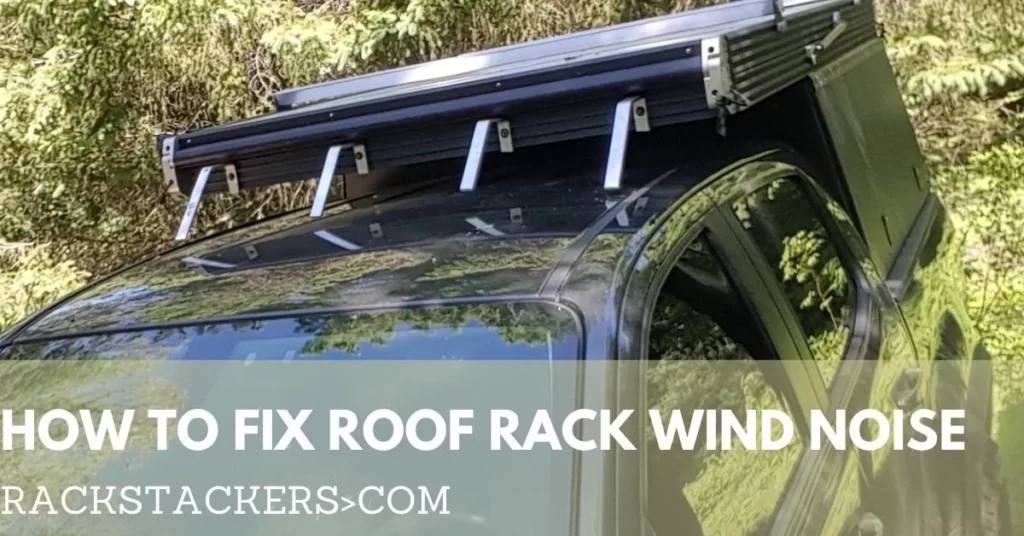How to Fix Roof Rack Wind Noise and Whistling? (Solution)
Have you ever experienced that annoying whistling sound coming from your roof rack while driving at high speeds?
It can be quite frustrating, not to mention distracting. But fear not, because we’re here to help you fix that pesky wind noise and restore the peace and tranquility of your driving experience.
So, fasten your seatbelt and let’s dive into the world of roof rack wind noise solutions!

Rooftop noise from your car’s rack is a common problem for many car owners. The noise can be caused by wind blowing through the bars, light amplification from the rack, and any loose straps which might cause a whistling sound.
There are a few simple things you can do to reduce these problems.
How to Fix Roof Rack Wind Noise and Whistling
There are a couple of methods to fix roof rack wind noise. Today we will be discussing step by step how to fix the problem of noise. All of them are super effective and easy to implement.
1. Identify the Source:
The first step in tackling wind noise and whistling is to identify the source of the problem. Start by inspecting your roof rack setup thoroughly.
Look for any loose or misaligned components, such as crossbars, mounts, or attachments. Even a small misalignment can cause wind noise.
Also, check for gaps or openings where the wind might enter, like loose-fitting accessories or improperly closed covers.
2. Tighten Things Up:
Once you’ve identified any loose components, it’s time to get handy with your tools. Grab a wrench or screwdriver and tighten everything up.
Make sure all bolts, clamps, and brackets are properly secured. Pay close attention to the connections between the rack and your vehicle’s roof. Snug them up to eliminate any potential gaps or movement that could generate wind noise.
3. Apply Rubber or Foam Strips:
If you’re still experiencing wind noise after tightening everything up, try adding rubber or foam strips to the contact points between the roof rack and your vehicle.
These strips act as a barrier, reducing vibrations and minimizing wind noise. Apply them to areas where the rack connects with the roof, such as the mounting points or where the crossbars meet the supports.
4. Adjust the Rack’s Position:
Sometimes, a minor adjustment in the positioning of your roof rack can make a world of difference. Experiment with moving the rack slightly forward or backward to find the sweet spot where wind noise is minimized. It may take some trial and error, but finding the optimal position can significantly reduce whistling sounds.
5. Remove Unnecessary Attachments:
Take a critical look at your roof rack and assess whether you have any unnecessary attachments or accessories that might be contributing to wind noise.
Items like bike racks, cargo boxes, or ski carriers can create additional wind resistance and turbulence, leading to more noise. If you’re not using them regularly, consider removing them when they’re not in use to reduce wind noise.
6. Test Drive and Fine-Tune:
After implementing the above steps, take your vehicle for a test drive to evaluate the effectiveness of your efforts. Pay attention to any remaining wind noise or whistling sounds.
If you still notice some noise, try making further adjustments or consider additional solutions like specialized wind fairings or noise-reducing pads.
7. Use Aerodynamic Accessories
One of the primary causes of wind noise is the shape of the roof rack and the accessories attached to it. Traditional square or round crossbars tend to produce more wind noise due to their flat surfaces.
Consider upgrading to aerodynamic crossbars or wind deflectors specifically designed to minimize wind resistance and noise. These sleek accessories are designed to redirect airflow and reduce whistling sounds.
Aerodynamic crossbars allow air to glide around the crossbars without making noise because of the Oval shape design instead of round or square.
They are also designed to minimize air resistance by “shearing” wind off of the crossbars. They look cool and look high quality. And they are fuel-efficient.
There are 2 market leaders in the aerodynamic crossbar section-
Both choices are good for you. They are of the same quality, same price range and also look the same. So, go for the brand you like, Thule or Yakima.
Regardless, both crossbars dramatically reduce wind noise while driving. Neither of these products is only a good choice but they are the best choice for aerodynamic crossbars.
8. Buy a Roof Rack Wind Deflector/ Wind Fairings
What is a wind fairing? A roof rack wind fairing/ deflector is a tool that decreases the sound of wind coming in contact with the car which is made from plastic.
Wind fairings can be purchased in various shapes and sizes, and come in a variety of colors. Each wind fairing is a universal design, and they attach to the front crossbar of your car.
The top section of the wind fairing attaches to the front crossbar, while the bottom rests on top of the car. The one exception is some wind fairings that attach to the vehicle from the top of the windshield, instead of the front crossbar.
On the top section of the wind fairings, there is a plastic piece that fits in between your headrests. This is what attaches to your roof.
You will need to make sure the piece of plastic is lined up exactly with the holes in your windshield, and you should also ensure it is correctly positioned on top of your windshield.
One of the most popular wind fairings on the market is The INNO universal mount wind deflector. It fits almost all crossbars and vehicle widths. It is affordable, high-quality, and durable. It is sleek and highly functional.
How Much Do Wind Fairings Cost?
Wind fairings cost between $60 and $120, depending on the brand, size, quality, and design.
Before you make a purchase, it’s always important to know whether the item is going to work with your car and roof rack. Because most manufacturers make wind fairing that is only compatible with the roof rack of their brand. So, they are generally costly.
On the other hand, a universal fairing can be a good choice because it works with different brands and models and it is cheaper compared to the other type.
The size of your wind fairing may also influence its price. The width and height of your vehicle’s roof rack, in conjunction with the length of your wind fairing, will ultimately determine its price.
Wind fairing prices can also be affected by design and material. Some wind fairings come in different colors or designs, such as carbon fiber print. All these factors may drive up the price.
Choosing the Best Roof Rack Wind Fairing
When picking out a roof rack wind fairing, you should take into consideration features like quality, design, and how it will best fit your vehicle.
Just like picking out anything, it’s hard to know exactly what you want. You should take your time and consider your options.
Normally, when choosing a wind deflector you have to check the size and the price. Another important feature to look for is how quickly it attaches. You want something that doesn’t take too long to install.
You should always choose a wind fairing that stretches the length of your crossbars, without exceeding it.
Use a measuring tape or check your crossbar’s length and check the product information of the wind deflector. It is important so that the wind fairing covers the entire crossbar length and doesn’t stick out of the crossbar
Don’t go for a cheap quality wind deflector because of the price. The cheaper models of wind deflectors aren’t made to last long and they may also fall off of your car. Always go for a trusted brand on the market for a more durable product.
8. Roof Rack Wind Deflector DIY
If you like DIY options and don’t want to spend the money to buy wind fairing/ wind deflector, there is a simple and easy way to stop the whistling.
Channel your inner MacGyver and just simply wrap a bungee cord around your crossbars in a tight spiral position, and attach the cord at both ends. A 4-foot-bungee-cord might do the trick for most of the crossbars. But you may have to adjust according to your crossbars. Just remember it has to be in a tight spiral position.
If you still have wind noise then watch videos on youtube for other DIY solutions or purchase a wind fairing.
Why Do Roof Racks Make Noise?
When the rack system is in place and secure, your rooftop should be quiet and there should be no sound or whistling from the roof rack but when you’re driving down the highway at a high speed, there can be a distinct “clacking” sound coming from the roof rack.
When the rack system is loose and rattling, you’ll hear all sorts of noises such as grinding noises and other noises that aren’t normal while driving.
So, why does the roof rack make noise? The whistling type noise coming from the roof rack is caused by the wind passing over the crossbar on top of your car, which is also known as drag.
When the wind passes through your crossbar, the surface of the crossbars blocks the airflow, which transforms into sound.
Conclusion
Remember, it’s essential to maintain a balance between reducing wind noise and ensuring the security and stability of your roof rack. Don’t compromise on safety for the sake of eliminating noise.
If you’re unsure about any adjustments or fixes, it’s always a good idea to consult the manufacturer’s instructions or seek assistance from a professional.
So, there you have it! With these tips and tricks, you can bid farewell to those irritating roof rack wind noises and enjoy a serene and peaceful drive. Embrace the wind, but keep the noise at bay!
Visit our kayak roof rack section for more kayak rack guides.
